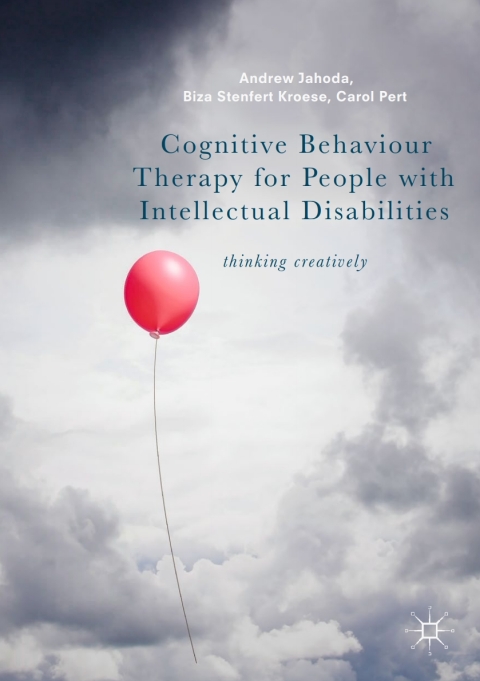Description
Efnisyfirlit
- Preface
- References
- Contents
- 1: Introduction
- Why Did We Write This Book?
- What Position Are We Coming from?
- How Did We Write This Book?
- What Is in This Book?
- What Next?
- References
- 2: History and Theory
- CBT: An Evolving Therapy?
- The Evidence
- Deficits and Distortions
- Making Therapy Meaningful: Asking the Right Questions
- Therapy in Context
- A Theoretical Framework: The Social Self
- Therapeutic Sessions: An Interpersonal Process
- Conclusions
- References
- 3: Current Context
- Service Responses to People with Intellectual Disabilities and Mental Health Problems
- Why Such High Prevalence of Mental Health Problems?
- Access to CBT for People with Intellectual Disabilities
- CBT Demand Characteristics
- How Can We Make CBT Accessible for People with Intellectual Disabilities?
- Recent Research Findings on Clients’ Cognitive Capacity
- Other Factors: Meeting Halfway?
- References
- 4: Assessment and Setting the Scene for Cognitive Behaviour Therapy
- Making a Start
- Before We Start: Where to Meet?
- Hearing the Client’s Story and Creating a Safe Place
- Setting the Scene
- Finding the Right Pace
- Is CBT Suitable?
- Using Storyboards to Explore Social Cognition and Emotional Understanding
- Standardised Assessments
- Self-Monitoring and Diaries
- Common Stumbling Blocks
- Helpful Building Blocks: What You Can Do
- Problems Due to Cognitive Characteristics
- Increasing Compliance
- Choosing the Best Fit for Your Client
- Choosing Rating Scales: How Much and How Often
- Self-Perceptions
- References
- 5: The First Stage of Therapy
- Before Moving Forward: Taking Stock About the Model to Be Used
- Adapting CBT to the Needs of an ID Client
- Socialising into the Model
- Tapping into Clients’ Thoughts and Underlying Schema or Views of Self
- The Way You Think
- Understanding Distress
- The Role of Emotion
- A Shared Formulation
- References
- 6: Therapeutic Change
- A Continuing Need for Structure
- Behavioural Change
- Establishing a Therapeutic Dialogue
- Working with Thoughts and Feelings (Bottom Up and Top Down)
- Top-Down Approaches and Behavioural Experiments
- The Way You Think
- Perceptions of Self and Working with Stigma
- Real Changes
- Dealing with Setbacks
- Finishing Therapy
- Working with Different Presentations and Challenges
- References
- 7: And Another Thing… Adapting Therapy for Particular Cognitive Impairments
- Working with Memory Problems
- Problems of Attention and Distractibility
- Communication Difficulties
- Problems of Cognitive Rigidity
- Presenting Problem
- Clinical Interview and Background Information
- Self-Monitoring
- Social Understanding
- Identifying Helpful and Unhelpful Thoughts
- Aspects of Alan’s Presentation that Obstructed Therapy
- Draft Formulation
- Feeding Back an Accessible Formulation
- Intervention. A Concrete Plan
- Making the Thinking Feeling Link: One Thing Leads to Another
- Guidance Towards Reappraisal
- How True on a Scale of 0–10?
- Balanced Thinking
- But How Does This Work in Real Life?
- Getting Stuck on Thoughts
- Gaps in Therapy
- Progress Made
- Real Changes Too
- Conclusions
- References
- 8: Group Work
- Why Consider Group Work for People with ID?
- What Do Clients Think About Groups?
- Some Considerations
- Preparation
- Group Identity
- Making the Group Accessible and Safe
- Support Staff
- Enforcement of Group Rules
- Cognitive Strategies
- Peer Support
- Endings and Then?
- References
- 9: Mindfulness and Third Wave Therapies
- Mindfulness in Health Settings
- Mindfulness and People with Intellectual Disabilities: What’s the Evidence?
- So What Is Mindfulness?
- Mindfulness: A Different Process
- Mind and Body
- Mindfulness: A Different Relationship with Your Problems
- Mindfulness: A Different Relationship with Your Thoughts
- A Different Relationship with Yourself: Using Compassion
- Ways of Adapting Mindfulness
- Keep It Real: Making Sense of Abstract Concepts
- Making Mindfulness Relevant
- Make It Easy: Engaging People with Intellectual Disabilities in Mindfulness
- The Problem of the Wandering Mind
- Keep It Short and Repeat Often
- Working with Compassion
- Adapting Mindfulness to Suit Different Physical Needs
- Practising at Home
- Mindfulness Isn’t for Everyone
- Conclusions
- References
- 10: Working with Others
- Family Members
- Support Staff
- Health and Social Services Professionals
- Specialist Services
- References
- 11: Making a Real Difference
- Why Train Therapists
- A Framework for Specialist Training
- Materials and Supervision
- Increasing Access and the Mainstreaming Debate
- Manuals: Mapping a Way Ahead
- Broadening Access to CBT
- Conclusion
- References
- 12: Final Thoughts
- References
- Index







Reviews
There are no reviews yet.